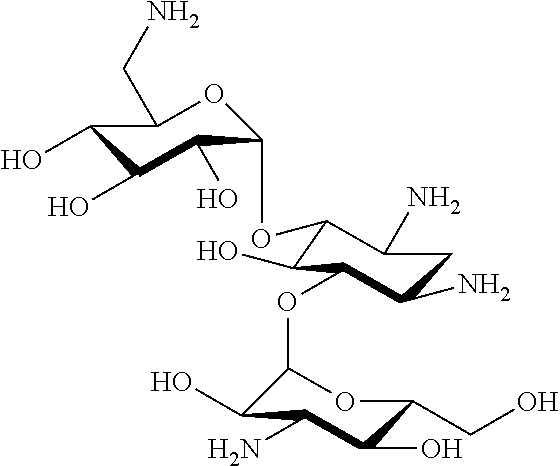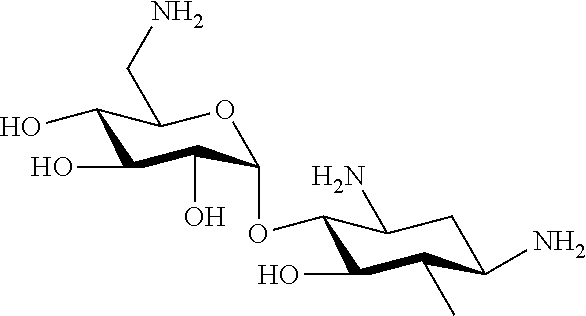Aminoglycosides: synthesis and use as antifungals
a technology of aminoglycosides and antifungals, applied in the field of antimicrobials, can solve the problems of reducing the effectiveness of aminoglycosides, forming defective cell proteins, and being highly toxic to patients, and achieves improved antimicrobial and particularly antifungal properties, improved fungicidal activity, and increased specificity for fungal pathogens
- Summary
- Abstract
- Description
- Claims
- Application Information
AI Technical Summary
Benefits of technology
Problems solved by technology
Method used
Image
Examples
example 1
6″-O-octanesulfonylkanamycin A (K20)
[0066]
[0067]In reference to Formula 2, Tetra-Boc protected Kanamycin (B4K) can be prepared with reported method (J. Med. Chem. 1991, 34, 1468-1476). A solution of B4K (90 g), octanesulfonyl chloride (64 mL) in anhydrous pyridine (800 mL) was stirred at 0° C. overnight allowing the temperature to warm up to room temperature. The clear brownish was stirred for another 6 days at room temperature and one day at 40° C., and then concentrated to oily crude product. Water (500 mL) was added and the mixture was stirred for another day. The mixture was transferred to a separatory funnel with more water and EtOAc (2 L). The organic layer was washed with 0.5 N HCl(aq) (×2) and water. The washing sequence was repeated for 3-4 times. If solid precipitation (mostly unreacted B4K) occurs, the organic layer needs to be filtered first to remove the solid. After completion of the washing, the EtOAc solution was filtered through a Frit funnel and the EtOAC was evapo...
example 2
Relative Growth Inhibitory Activities of K20 Against Bacteria and Fungal Species
[0070]
TABLE 2Growth inhibitory activities of K20against bacteria and fungal speciesOrganismaRelative Activity(Bacteria)Staphylococcus aureus+++Micrococcus luteus++(Fungi)Rhodotorula pilimanae+Typhula ishikarensis++Microdochium nevale++Fusarium oxysporum++Phoma beta++Botrytis cinera+Bipolaris spp.+Fusarium graminarumb+++ Verticillium spp.++aDetermined by disk diffusion agar plate assays+ = some activity++ = moderate activity+++ = considerable activitybSeparate microbroth dilution growth inhibition tests show MICs of 7.8-15.6 microgram mL−1
[0071]Referring now to Table 2 there is shown the relative growth inhibitory activities of K20 against various species of bacteria and fungi as determined by disk diffusion agar plate assays. While K20 showed both antibacterial and antifungal activity what is of considerable importance is the activity shown against Fusarium graminarum. Fusarium graminarum is a fungus tha...
example 3
Antifungal Activities of Other K Compounds Against Fusarium graminearum and / or Rhodotorula pilimanae
[0072]Referring now to Table 1 there is shown the relative growth inhibitory activities of K20 against Fusarium graminearum and / or Rhodotorula pilimanae as determined by disk diffusion agar plate assays. The alkylsulfonyl, alkylcarbonyl, and alkylthio derivatives of kanamycin A were shown to be more active than the alkylamino and toluene (p-methylphenyl) derivatives which, nevertheless shows some antifungal activity.
PUM
| Property | Measurement | Unit |
|---|---|---|
| volume | aaaaa | aaaaa |
| volume | aaaaa | aaaaa |
| diameter | aaaaa | aaaaa |
Abstract
Description
Claims
Application Information
 Login to View More
Login to View More - R&D
- Intellectual Property
- Life Sciences
- Materials
- Tech Scout
- Unparalleled Data Quality
- Higher Quality Content
- 60% Fewer Hallucinations
Browse by: Latest US Patents, China's latest patents, Technical Efficacy Thesaurus, Application Domain, Technology Topic, Popular Technical Reports.
© 2025 PatSnap. All rights reserved.Legal|Privacy policy|Modern Slavery Act Transparency Statement|Sitemap|About US| Contact US: help@patsnap.com



